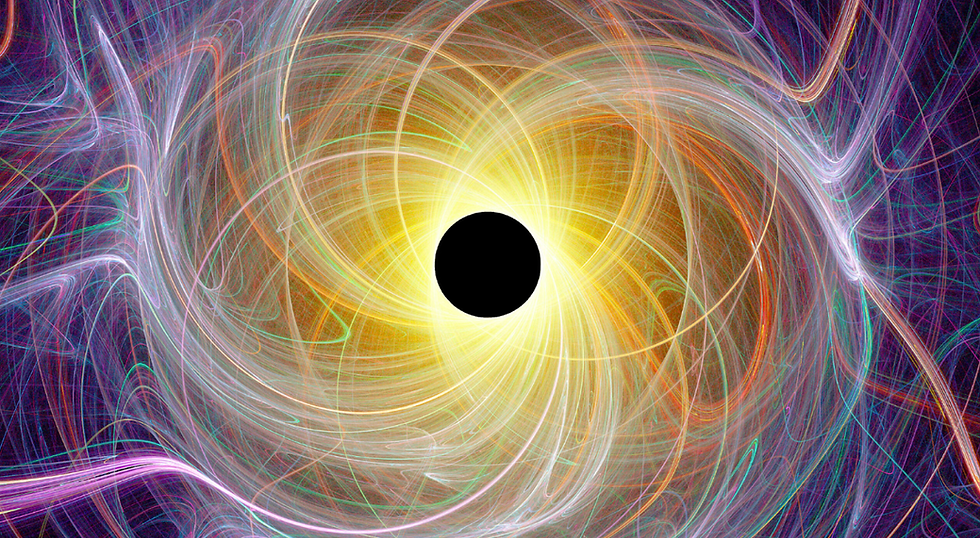Accretion Disks, Hawking Radiation, and its First Couple Pictures: What Secrets do Black Holes Hold?
- Destin Hoffman

- Aug 8, 2022
- 3 min read
Updated: Aug 10, 2022
Black Holes have a lot of other fascinating properties! Click here to learn about hawking radiation, the black hole's accretion disk, and the first picture of a black hole!

Figure 1: Picture of a rocket flying into space
Introduction
Black holes have always been an object of great mystery to both scientists and the general public alike for decades, particularly in films like Interstellar (2014), Star Trek (2009), and Event Horizon (1997). These mysterious objects are one of the most used resources in time-traveling science-fiction, and have captivated audiences with their frightening and invisible nature.
Black holes in films were usually imagined as being a round dark center surrounded by swirling, glowing matter – literal holes in the space-time fabric of the universe! However, with the help of renowned theoretical astrophysicist Kip Thorne, the portrayal of black holes had been revolutionized with the utmost accuracy while also charming audiences with their beautifully warped glow. Kip Thorne, with the use of computers that simulated Einstein's field equations, had turned science-fiction into science fact.
Besides entertainment, Thorne's work catalyzed a handful of major discoveries about black holes, such as the first photograph of a supermassive black hole called Messier 87. While the image was a bit fuzzy, the photograph was a massive breakthrough, confirming the presence of an accretion disk predicted by Kip Thorne and other scientists. 2022 also saw a second unveiling of the Milky Way’s own black hole thanks to astronomers at Harvard's Smithsonian Center for Astrophysics.

Figure 2: Picture of M87, a supermassive black hole. Known as the First Picture of a Black Hole
The Accretion Disk
So what exactly is an accretion disk? This ring of glowing light surrounding some black holes is from the hole feeding on matter from stars, gas, or dust. The charged glow of the accretion disk comes from the production of the electromagnetic radiation given off by superheated gas and dust whirling around the black hole at immense speeds, revealing their location. These accretion disks can also produce jets of particles and radiation blasting out from the black hole's poles at near light speed. The phenomenon by which black holes feed on sufficiently close stars is known as tidal disruption events and is the primary method of astronomers detecting and observing black holes.

Figure 3: Anatomy of an Accretion Disk
Hawking Radiation
While most think that black holes have an eternal lifespan due to their unbeatable and infinite gravity, this is simply not true. According to Stephen Hawking and his theory of black hole entropy – Hawking Radiation – the quantum nature of space outside the event horizon gives way to the steady conversion of quantum fluctuations into pairs of virtual particles where a particle-antiparticle pair, instead of annihilating, loses its partner to the black hole's event horizon. This process, in turn, causes the black hole to steadily lose mass over time, eventually evaporating entirely.
The more scientists learn about black holes, the more we can learn about the beginning and inevitable end of our universe. Black holes, additionally, act as laboratories for combining the two pillars of modern theoretical physics: general relativity and quantum mechanics, giving us a theory of everything that describes both the smallest fundamental elementary particles to the evolution of galaxies. In the meantime, thanks to filmmakers like Christopher Nolan, we can experience centuries of wonderful work by physicists and astronomers from the comfort of our homes.

Figure 4: The process of Hawking Radiation
Citations
Hashtags: #astronomy #science #Sciencebehindit #personalopinion #Blog #scienceresearch #blackholes #accretiondisk #firstpictureofablackhole #M87 #nowscience #formation #howitis #spaghettification #facts






Comments